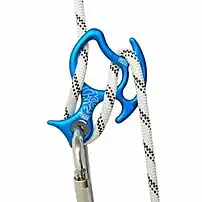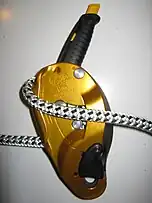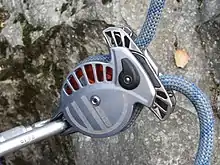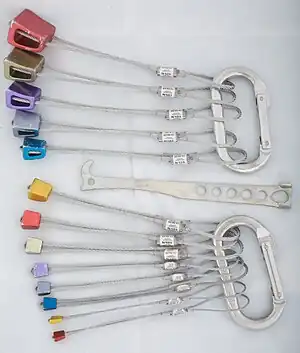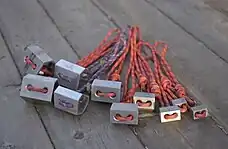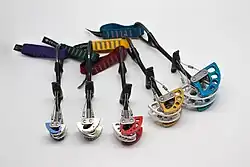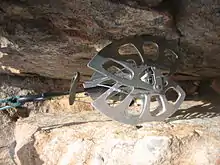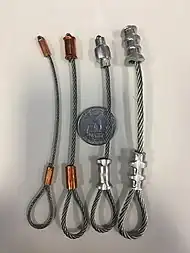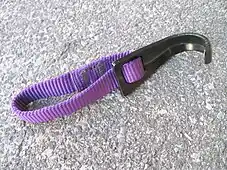Rock-climbing equipment
Rock-climbing equipment varies with the type of climbing undertaken. Bouldering needs the least equipment outside of shoes and chalk and optional crash pads. Sport climbing adds ropes, harnesses, belay devices, and quickdraws to clip into pre-drilled bolts. Traditional climbing adds the need for carrying a "rack" of temporary passive and active protection devices. Multi-pitch climbing (and big wall climbing) adds devices to assist in ascending and descending fixed ropes. And finally aid climbing uses unique equipment (e.g. aiders).
| Part of a series on |
| Climbing |
|---|
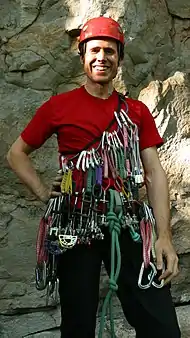 |
| Lists |
| Types of rock climbing |
| Types of mountaineering |
| Other types |
| Key terms |
Advances in equipment are a key part of the rock climbing history, starting with the climbing rope. Modern devices enable climbers to perform tasks that were previously done manually and with greater control (in all conditions) and less effort. Examples of replacements include the harness (replaced tieing the rope around the waist), the carabiner (replaced many knots), the descender/abseil device (replaced the dülfersitz), the ascender (replaced the prusik knot), the belay device (replaced the body belay), and the nuts/hexes (replaced chockstones).
Modern equipment includes dynamic ropes, plyometric training tools, advanced spring-loaded camming devices (SLCDs) for protection, and advanced rope control devices such as self-locking devices (SLDs), progress capture devices (PCDs), and assisted braking devices (ABDs). Modern equipment uses advanced materials that are increasingly more durable, stronger, and lighter (e.g. spectra/dyneema and aluminum alloys). The equipment must meet specific standards (e.g. the UIAA standards) for strength, durability, and reliability, and must be certified and tested against such standards (with individual pieces carrying such certification marks).
Use and certification
Type of climbing
The rock-climbing equipment needed varies materially depending on the type of rock climbing being undertaken. Starting from the least equipment-intensive type of climbing, the general equipment needs are as follows:[1]
- Free solo climbing (and its deep-water soloing variant) require the least equipment as no climbing protection (and related rope equipment) is used. Equipment is limited to climbing shoes and chalk (with chalk bag).
- Bouldering (and its competition bouldering variant) uses the basic equipment of free soloing but with the optional addition of bouldering mats (also called crash mats/crash pads).
- Top rope climbing (and its competition speed climbing variant) adds a rope, harness, and belay device, but no general climbing protection outside of that which is used to create the anchor point at the top of the climb from which the top rope is hung (which is usually done with carabiners, slings, and/or cord).[2]
- Sport climbing (and its competition lead climbing variant) adds quickdraws that are clipped into the pre-drilled in-situ bolts while the climber is lead climbing the route. No additional climbing protection is needed.[2]
- Traditional climbing requires most of the equipment of the above disciplines but with the addition of extensive climbing protection equipment (nuts, hexes, and SCLDs), which the climber will insert while lead-climbing the route. The weight of the extra climbing protection may require a stronger harness and/or a gear sling.[2]
- Multi-pitch climbing, which can be done in sport or traditional formats, requires added rope devices like ascenders and descenders for moving up and down fixed-ropes. The big wall climbing variant requires heavy-duty rope devices for carrying more gear such as portaledges and provisions (which are carried in haul bags).
- Rope solo climbing is done in many formats (sport, traditional, multi-pitch), and needs an extensive range of rope devices as every pitch needs to be solo climbed (SLDs), descended back down (descenders), and then re-ascended (ascenders).[3][4] The simpler variant of top rope solo climbing, only requires the SLDs.[5]
- Aid climbing (and its clean aid climbing variant) is usually done in a traditional format and also more likely on multi-pitch (and big wall) routes. In addition to the standard equipment for such routes, aid climbing uses specialist equipment such as aiders and daisy chains, as well as hammers for pitons and coppeheads.[6]
Certification

Rock-climbing equipment is broadly classed as Personal Protective Equipment (PPE).[7] The UIAA was an important early body in setting standards (and pre-1995 it was the only body setting standards) for equipment, and the UIAA Safety Commission continues to play a central worldwide role in this area.[8] The European CEN is also an important major regulator of PPE, and which works closely with the UIAA Safety Commission through its CEN Working Group for Mountaineering Equipment.[9][10] North America has fewer specific regulations as rock-climbing equipment as it is not classed as military or professional PPE and thus does not fall under OSHA regulation;[10] in effect, the UIAA and CEN have become the most important bodies for setting standards and regulating rock-climbing equipment worldwide, and most major manufacturers (and distributors) produce equipment certified and stamped with UIAA and CE marking.[10] Post Brexit, the United Kingdom use "UKCA" certification in lieu CEN.[7]
Ropes and slings
Ropes

Modern climbing ropes are 50–80 metres (160–260 ft) in length (the longer versions are for multi-pitch climbing), and have a kernmantle construction consisting of a core (kern) of twisted nylon fibers and an outer sheath (mantle) of woven colored coarse nylon fibers. They are either dynamic ropes, which can stretch to absorb the energy of a falling climber, or are the less expensive but more hard-wearing static ropes, which are only for use in constant-load situations such as descending (e.g. abseiling) and ascending (also called fixed-roping).[1][11][12]
Some climbers will use a single climbing rope of full-thickness (circa 9–11 mm), whereas others will use double ropes (or "half-ropes") to reduce rope drag (e.g. they are not both clipped into each anchor or protection point), which have less thickness (circa 8–9 mm) to limit the weight of the extra rope. Where two thinner ropes are used that are both clipped into each anchor or protection point (i.e. it is not to reduce rope drag, but instead to have a backup rope for long climbs), it is known as twin roping, which are (circa 7–8 mm).[1][11][12]
Slings

Modern webbing (or "tape"), is made of strong tubular nylon and/or the even stronger spectra/dyneema material. Climbers use webbing that has been sewn (using a certified standard of reinforced stitching) into various lengths of closed loops called "slings" (or "runners") that can be used in a wide range of situations, including wrapping around sections of rock (for abseiling, or creating belay anchors, or as passive protection), or tied to other pieces of equipment (often via carabiners) to create a longer version of a quickdraw or even a makeshift lanyard.[1][11][13]
Slings can be made into more complex pieces of equipment such as the daisy chain, which is used in aid climbing,[6] and the Personal Anchor System, which is used in securing a climber to a fixed anchor point.[14]
Cords

While lengths of webbing can be tied via a knot (e.g. a water knot) to create custom-length loops (instead of the pre-sewn fixed-length slings), their load-bearing capacity can be materially reduced making them less safe. Climbers instead use cord (or "accessory cord"), which is a length of thinner (circa 4–8 mm) static kernmantle rope, tied via a double fisherman's knot into closed loops of any size.[1][11]
Cord loops (also known as "cordelettes") serve a wide variety of functions in rock climbing including creating friction prusik knots for ascending or gripping fixed climbing ropes (usually using thinner circa 5–6 mm cord), or for attaching to, and equalizing forces across, multiple fixed anchors points,[15] such as when setting up abseil or belay anchors on multi-pitch climbing routes (usually using thicker circa 7–8 mm cord).[1][11]
Rope connectors
A number of devices help climbers securely attach items to the rope, including themselves (e.g. via a harness) and protection devices (e.g. via carabiners and quickdraws). Before their invention, climbers used alternative techniques such as looping the rope around the body in lieu of a harness (e.g. the body belay), or around the rock in lieu of protection, as well as using various climbing knots to link ropes and anchor points together.[1]
Carabiners
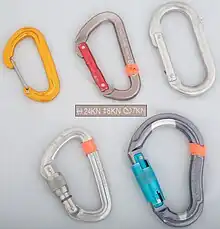
Carabiners are closed metal clips with spring-loaded gates that are used as connectors between the rope and various devices. Modern carabiners are made from a lightweight but strong aluminum alloy that can withstand the load of a fall. Carabiners come in various shapes (e.g. the asymmetric/offset D-shape is the most common), and gate styles (e.g. a straight gate or a bent gate). A particular variation is whether the gate is locking (for extra security for example when belaying, but making the carabiner heavier and slightly tricker to clip into) or non-locking (the easiest to clip into and out of for example when leading a bolted sport climbing route, but with the risk that the gate may unintentionally open).[11][1][16]
Harnesses
Climbing harnesses are used for connecting the rope to the climber (via a "belay loop" on the harness). Harnesses are made of strong materials to specific strength guidelines that can withstand the load of a major fall. There are many types of harness designs (and materials used) depending on the type of climbing undertaken. Examples include minimal "sit" harnesses for sport climbing (e.g. they require little in the way of gear-carrying loops), lightweight and detachable leg-loop harnesses for alpine climbing (e.g. to fit around heaving winter clothing), padded harnesses for big wall climbing (to give comfort for long hanging belays and abseils), and chest/full-body harnesses for children and when carrying heavy loads.[11][1]
Lanyards
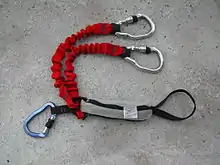
Lanyards (or "teather", or "via ferrata set") are much longer versions of quickdraws that attach from a harness to a rope (or other anchor points, such as a metal cable). The difference is that lanyards are much stronger than quickdraws and are capable of withstanding fall factors of 2 as found on via ferrata or on multi-pitch climbing routes. They are often made from materials that can absorb dynamic energy and often come with additional optional fall energy absorption devices, and lanyards that have had heavy falls often have to be discarded. Lanyards are also constructed to be sufficiently flexible to resist being twisted.[1][17]
Personal Anchor Systems
A sub-class of lanyards is the Personal Anchor System (PAS), which is a section of rope or interconnected chains of slings, which are used to tie the harness to an anchor point such as a belay station. Traditionally, climbers would tie their harness to anchors using part of the climbing rope; however, the PAS has become popular as a way to avoid reducing the effective length of the climbing rope, and to use a more straightforward and direct connection.[18]
Quickdraws
.jpg.webp)
Quickdraws are used by climbers to connect ropes to fixed items such as bolted anchors in sport climbing, or protection devices in traditional climbing. The quickdraw consists of two non-locking carabiners connected together by a short, pre-sewn loop of webbing. They are used to reduce the friction and drag between the rope of the fixed item (i.e. instead of just clipping into a carabiner clipped into the bolt); in competition climbing the quickdraws are already hanging from the bolts, which is called pinkpointing in sport climbing (i.e. instead of the lead climber carrying the quickdraws, they are already in-situ). The quickdraws used on advanced sport and competition climbing routes often have a "bent-gate" on the lower carabiner to make clipping-in easier.[11][19]
Rope devices
A number of devices are used for controlling the rope (belay devices and self-locking devices), moving up the rope (ascender devices), or moving down the rope (rappel/abseil or descender devices). These actions were historically done by climbers with no devices (e.g. the body belay for belaying, the dülfersitz abseil for descending, and the prusik knot for ascending), and the devices help with control and safety in all conditions (e.g wet or icy ropes).[1]
Ascenders
.jpg.webp)
Ascenders (also called "jumars" or "crolls" after popular brands) are mechanical devices to enable a climber to move up a fixed rope (e.g. a static rope that is hanging from a fixed anchor). Ascenders perform the same basic function as friction or prusik knots made from cord but far less effort and concentration are needed to use them (e.g. tired climbers at high-altitude), they can handle much heavier loads (e.g. climbers with ruck-sacks), and they are more reliable in all conditions (e.g. on wet and icy ropes). The ascender uses an internal cam that allows the device to slide freely in one direction but tightly grip the rope when pulled on in the opposite direction. To prevent the ascender device from accidentally falling off the rope, a locking carabiner is also used.[14]
Belay devices
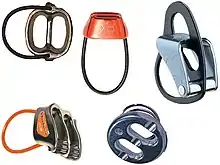
Belay devices are mechanical friction-brake devices used to control the climbing rope(s) when belaying a climber. Their main purpose is to allow the rope to be locked-off/fully-braked with minimal effort when arresting a climber's fall. There are many kinds of belay devices, such as the original passive braking devices like "sticht plates" and the later "tubers/tubulars" (e.g. the original Black Diamond ATC, or the Petzl Reverso).
Modern belay devices include auto-block belay devices that allow the belay device to be attached to a separate anchor point (e.g. and not to the belayer, which is useful for bringing up the second-climber on multi-pitch routes), and active assisted-braking devices (ABDs) that will self-lock with sudden rope movements (e.g. the Petzl GriGri or the Wild Country Revo). Some passive belay devices may also be used as descenders for abseiling.[20]
Indoor climbing walls can provide in-situ fixed mechanical auto belay devices that enable the climber to top rope a route alone; more recent lead auto belay models allow the climber to also lead climb the route alone.[21]
Descenders
Descenders (or abseil devices) enable a climber to abseil (or rappel) down a fixed rope (e.g. a static rope that is hanging from a fixed anchor). They perform the same basic function as the dülfersitz abseil but with more control and less effort. The classic passive descender, and still widely used, is the figure-eight, although it is offered in more complex variations with "ears" and "wings" to prevent the rope from locking up.[14]
Many passive belay devices can be used as descenders, such as tubers/tubulars. Some modern descenders come with self-locking device (SLD) features that will grip the rope in the event of an uncontrolled fall (e.g. the Petzl I'D S).[14] Heavy-duty descenders such as "rappel racks" are used for greater control and friction when carrying heavy loads and/or in very wet or icy conditions (e.g. big wall climbing and caving). The modern technique is to use a descender with a Personal Anchor System.[14]
Self-locking devices
Self-locking devices (SLDs), also called progress capture devices (PCDs), are the terms given to the broader class of rope devices that allow the climbing rope to move more freely in one direction but will lock quickly if the rope tries to move in the opposite direction. Their basic action means that several can also used as emergency ascenders or assisted-belaying devices (ABDs), but they come in a broad range for a variety of uses (e.g. as a hauling or rescue pulley, like the Petzel Traxion).[22]
The most complex use is for rope solo climbing, for which devices such as Wren's Silent Partner, the Petzel GriGri, and the Wild Country Revo have been used (rope solo climbing requires the widest range of rope devices including ascenders and descenders),[3][4] or the more straightforward top rope solo climbing, for which the Petzel Micro Traxion, and Camp Lift have been used.[5]
Protection devices
As discussed in types of climbing, rock climbing protection devices are mainly used in traditional climbing and in sport climbing (both of which can be done in single and multi-pitch formats). In addition, clean aid climbing also uses many of the traditional climbing protection devices.[2]
Temporary
Temporary protection devices (also known as pro, gear or the rack), provide the means to place temporary anchor points on the rock to which a lead climber can clip their rope (via a quickdraw) when traditional climbing; they also can be used for anchor points for belaying and for abseiling. The devices are categorized as being passive (i.e., they maintain a static position throughout), or active (i.e. they dynamically move or adjust in the case of a fall).[2]
Passive
- Nuts (also "stoppers", "wires" or "chocks"). The most common passive protection, are small curved blocks of strong aluminum alloy attached to a loop of wire. Nuts are used by wedging them into narrowing/tapering cracks (they do not work well in wide or parallel cracks) and then giving them a tug to set them in place.[2][23] Nuts are come in many varieties (e.g. offset-shaped HB nuts, micro nuts, and brass RP nuts).[24]
- Hexes. These are hollow asymmetrical hexagonal tubes attached to a loop of cord (particularly for large hexes) or wire. Being wider than nuts, they can be used in parallel and even widening cracks. They are placed like a nut ideally into a narrowing section of the crack and any fall will cause the hex to twist in its placement, thus exerting sideways force on the wall of the crack. Modern climbers tend to use SCLDs over hexes.[2]
Active
- Spring-loaded camming devices (SLCDs, or "friends", "camalots"). These consist of two to four aluminum cams mounted on a spring-loaded axle (or two adjacent axles), in such a way that pulling on the shaft connected to the axle forces the cams to narrow so they can be inserted into small cracks. Once the SLCD is inserted into the crack, its cams will maintain a constant camming angle of 13.75 degrees against the walls of the crack. SCLDs are overwhelmingly the most popular form of active protection device.[2][25]
- Tricams. These are shaped aluminum blocks attached to lengths of webbing tape (like a nut). The block is shaped so that pulling on the tape makes it "cam" dynamically against the crack walls, gripping the rock tighter (like an SCLD). Tricams are not as easy to place or remove as an SLCD but they can fit into narrow cracks and are much cheaper and lighter than SCLDs. Less frequently in use today.[2][26]
- Removable bolts (or RBs). These are a type of SLCD for insertion into pre-drilled bolt holes, but instead of using cams, the system uses a metal tube that once inserted expands to grip against the walls of the hole. Less frequently in use, their main application is for climbers creating bolted routes.[2]
Fixed
Fixed protection devices are permanent in-situ anchors to which a lead climber can clip their rope (via a quickdraw) when sport climbing; they also can be used to create anchor points for belaying and for abseiling. The main types are:[2]
- Bolts. Steel 1/2-inch expansion bolts are pre-drilled into the rock with a hand drill and tightened with a torque wrench (some versions use a type of glue to anchor the bolt).[2][27] Before insertion, a bolt hanger is attached into which carabiners (and quickdraws) can be clipped. Modern stainless steel (or the more expensive titanium, for even greater durability and/or harsher environments like sea cliffs) bolts last for over a decade, but have a finite life span after which they must be replaced.[28] Some bolted crags use fixed permadraws, which are in-situ wire quickdraws that are permanently attached to the bolt-hangers.[29]
- Pitons. Before bolts, climbers (and particularly big wall aid climbers and alpine climbers) used pitons, which are steel spikes (older versions were not steel) hammered into cracks in the rock that have an eye-hole for attaching a carabiner (some came with pre-installed metal rings). Unlike bolts, pitons need a crack into which they can be hammered, and come in a wide variety of shapes and designs (e.g., angles, knifeblades, lost arrows) to fit various cracks, and even micro-cracks like RURPs). Pitons have been largely replaced by the stronger bolts as the fixed protection of choice, but are still an important part of aid climbing (but not clean aid climbing, which rules out any use of hammers).[2][30]
Aid equipment
Aid climbing uses several of the above devices but in a way that gives "aid" to the aid climber in ascending (e.g. pulling up on pitons and hooks). There are also a number of other pieces of equipment that are more exclusively associated with aid climbing.[6]
- Aiders (or the French etriers). These are short 5–6 rung ladders made of lightweight webbing, which are a central part of the technique of aid climbing where they are normally used in pairs (e.g. the aid climber stands one on aider while clipping in the higher aider). Aiders can also come as "offset style" aiders (e.g. 5–6 stirrup-loops arranged on either side of a central rope) and as the light-weight "adjustable style" aiders (e.g. the climber can create customized rungs).[6]
- Daisy chains. These are 1 to 1.5 metre-long webbing slings that have multiple small loops (for carabiner attachment) which are made by stitching the sling at 8 to 15-centimetre intervals. Like aiders, daisy chains are also a central part of aid climbing where they link the harness to the aider (see above); care has to be taken not to clip into the loops incorrectly, which can cause the daisy chain to fail and rip apart (e.g. when trying to use as a Personal Anchor System).[6]
- Copperheads (or "bashie"). A type of soft-metal nut (usually made from copper), which can be hammered into very thin cracks that are too small for even the narrowest piton. Copperheads are only used in aid climbing and their low strength means that they can only handle the "static bodyweight" of an ascending aid climber, and will likely fail where the climber makes a dynamic fall. At times, climbers will "clean out" build-ups of copperheads on an aid climbing route.[6][31]
- Hooks. These are steel hooks of various shapes (e.g. bat hook, talon hook, grappling hook, etc.,) that are hung from cracks and flakes (e.g. the fifi hook and skyhook). Mostly used in aid climbing, but they have been used in extreme traditional climbing routes as a last resort (i.e.hook placements may not withstand a dynamic fall). A particular type of hook is a rivet hanger that can be attached to old metal rivets in the rock face.[6]
- Rock climbing hammers are mainly used by aid climbers to hammer in various types of pitons while ascending routes; note that clean aid climbing does not allow the use of hammers as all clean aid equipment must only be inserted on a temporary basis.[6]
Clothing equipment
Rock climbers use a number of pieces of specialized clothing equipment including:

- Belay glasses allow the belayer to look up at the lead climber without having to strain their neck upwards (i.e. the glasses are tilted upwards by 45 degrees), and are used when there is extensive belaying such as on long routes, or by climbing instructors.
- Belay gloves are used to protect the hands when doing lots of belaying (especially on big wall climbing routes), and their construction from leather or other hard-wearing materials, generally improves grip with the rope, which lessens the risk of a failure of the belay system.
- Climbing shoes are designed to increase the friction and thus grip of the foot with the climbing surface by using a sole of vulcanized rubber. Stiffer shoes are used for "edging", and softer soles for "smearing".[32]
Miscellaneous equipment
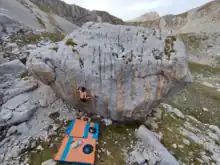
- Bouldering mats are used to protect boulder climbers from the frequent falls that happen in bouldering, which while shorter than other types of climbing, can be onto uneven or hard surfaces from awkward body positions, which could cause ankle or back injuries.
- Climbing chalk is used by all rock climbers to absorb moisture on their hands; the chalk is kept in a "chalk bag" that is hung around the waist area. US boulderer John Gill is largely credited with introducing "gymnastic chalk" to climbing in the 1950s (he was a gymnast himself).[32]
- Gear slings are loops of webbing (often with some padding) worn diagonally across the chest on longer traditional climbing routes (e.g. multi-pitch climbing) when the climber cannot comfortably arrange their protection equipment on the gear loops of their harnesses.
- Guidebooks are hard-wearing books (i.e. they will be taken on the climb) outlining the key details of the climbing routes including diagram (or topos) of the routes and the grades of difficulty of each individual pitch.
- Haul bags are large tubular bags of hardwearing construction (so they can be dragged over rock) into which supplies and climbing equipment can be carried on long multi-pitch routes; commonly used in big wall climbing where they are called "pigs" due to the effort of hauling them up on pulleys.[22]
- Medical tape ("tape" can also refer to webbing), is used by climbers to prevent and repair skin injuries. For example, tape lessens skin damage while hand jamming on rough granite surfaces; it is also used to cover skin that has been dangerously worn down on the fingers, while crack climbing.
- Nut tools (or "nut key") is a metal tool used to help retrieve nuts and hexes that have become firmly wedged into cracks.
- Portaledges are used in big wall climbing as a temporary overnight sleeping or even resting platform (e.g. for long belays).
- Pulleys are used by big wall climbers to help bring up haul bags and other equipment.
- Stick clips are long poles with a quickdraw at the end that can be clipped into the first bolt of a sport climbing route from the ground.
- Wire brushes are used to clean holds on routes, particularly at the higher graded climbing routes where the holds are very small and need to be completely dry and free of any debris or vegetation to be useable; climbers even use toothbrushes to clean the smallest holds without damaging them.
Training equipment
Various items of equipment are employed during climbing-specific training to strengthen the climber's fingers, tendons and muscles:
- Bachar ladder. A narrow flexible (e.g. it can be rolled up) all-metal, or PVC/webbing, ladder that is hung horizontally between two points (but usually with one point higher to create a slope), and where the climber ascends and descends the rungs using only their arm strength (i.e. no use is made of the feet); considered an early version of a campus board but that focused on arm strength and not hand/finger strength.[33]
- Campus board. A series of horizontal rungs attached to an overhanging surface that may be climbed up and down without the aid of the feet. When used properly, campus boards improve finger strength and also dynamic or plyometric, muscle strength.[34]
- Grip saver. A small device that can help in developing the antagonist muscles to those used while gripping with the hand. Use of such a device can prevent the ligament injuries that are frequently experienced by climbers.[35]
See also
References
- ACMG (2023). "Chapter 1: Materials and Equipment". Climbing Guiding Manual. Association of Canadian Mountain Guides. pp. 11–27. Retrieved 10 September 2023.
- The Mountaineers (2018). "Chapter 13: Rock Protection". Mountaineering: The Freedom of the Hills (9th ed.). Quiller Publishing. pp. 239–254. ISBN 978-1846892622.
- Black, Christian (3 February 2022). "Rope Solo Rock Climbing: Understanding How It's Done". GearJunkie. Retrieved 3 March 2023.
- Whittaker, Pete (14 August 2018). "How to Rope Solo". UKClimbing. Retrieved 3 March 2023.
- Wharton, Josh (25 August 2022). "Top-rope soloing: How Josh Wharton Climbs Multi-pitches Faster and With Less Energy". Climbing. Retrieved 5 March 2023.
- The Mountaineers (2018). "Chapeter 15. Aid and Big Wall Climbing". Mountaineering: The Freedom of the Hills (9th ed.). Quiller Publishing. pp. 276–317. ISBN 978-1846892622.
- Middleton, Dan (13 January 2023). "Guidance on gear recalls and safety warnings". British Mountaineering Council. Retrieved 14 September 2023.
- McNae, Andy (4 October 1999). "Climbing equipment standards". British Mountaineering Council. Retrieved 14 September 2023.
- Middleton, Daniel (8 October 2019). "Behind the scenes: equipment". British Mountaineering Council. Retrieved 14 September 2023.
- Saunders, Samantha (18 October 2018). "Behind the Scenes: How Climbing Harnesses Are Designed and Tested". Climbing. Retrieved 14 September 2023.
- The Mountaineers (2018). "Chapter 9: Basic Safety System". Mountaineering: The Freedom of the Hills (9th ed.). Quiller Publishing. pp. 134–154. ISBN 978-1846892622.
- Potter, Stephen (25 July 2022). "Your Complete Guide to Rock Climbing Ropes". Climbing. Retrieved 10 September 2023.
- Middelton, Daniel (17 March 2016). "Slings for climbers". British Mountaineering Council. Retrieved 10 September 2023.
- Long, John; Gaines, Bob (August 2022). "Chapter 10: Rappelling and Rope Ascending". How to Rock Climb (6th ed.). Falcon Guides. p. 285-290. ISBN 978-1493056262.
- Martin, Jason (30 January 2023). "How to Build an Anchor in Poor Rock". Climbing. Retrieved 15 September 2023.
- Middelton, Daniel (2 September 2014). "Karabiners and connectors for climbers". British Mountaineering Council. Retrieved 10 September 2023.
- Dawes, Carey (16 July 2015). "Get into via ferrata: the gear". British Mountaineering Council. Retrieved 10 September 2023.
- Long, John; Gaines, Bob (August 2022). How to Rock Climb (6th ed.). Falcon Guides. p. 270. ISBN 978-1493056262.
- Middelton, Daniel (25 September 2014). "Quickdraws: a guide for climbers". British Mountaineering Council. Retrieved 10 September 2023.
- Long, John; Gaines, Bob (August 2022). "Chapter 3: Belay Devices, Carabiners, Slings and Quickdraws". How to Rock Climb (6th ed.). Falcon Guides. p. 31-54. ISBN 978-1493056262.
- Achs, Jordan (2 July 2016). "No Belayer Necessary: Understanding Autobelays". Climbing. Retrieved 2 October 2023.
- Achey, Jeff (14 June 2023). "Haul Your Pack to Climb Faster and Harder". Climbing. Retrieved 15 September 2023.
- Achey, Jeff; Ellison, Julie (8 August 2022). "What You Need to Know About Nuts". Climbing. Retrieved 12 September 2023.
- Achey, Jeff (27 April 2022). "Before "the Nut" There Was "the Pebble"… and It Was Sketchy". Climbing. Retrieved 12 September 2023.
- Van Leuven, Chris (17 July 2017). "The History of Friends". Climbing. Retrieved 12 September 2023.
- Fox, Amanda (6 September 2013). "Tricams 101: A Guide to Using This Tool". Climbing. Retrieved 12 September 2023.
- Carpenter, Shelby (4 November 2015). "What Happens When Climbing Bolts Go Bad?". Outside. Retrieved 12 September 2023.
- Hildenbrand, Bruce (30 August 2021). "You Trust Your Life To That? Here's How to Identify Dangerous Climbing Bolts". Climbing. Retrieved 12 September 2023.
- Scott, Virgil (3 June 2014). "The dangers of worn perma-draws". British Mountaineering Council. Retrieved 12 September 2023.
- Erikson, Jim (2 August 2023). "Everything You Need to Know About Placing, Evaluating, and Trusting Pitons". Climbing. Retrieved 12 September 2023.
- Synnott, Mark (17 February 2006). "Big Wall Copperheading". Climbing. Retrieved 13 September 2023.
- Long, John; Gaines, Bob (August 2022). "Chapter 1: Knots and Basic Equipment". How to Rock Climb (6th ed.). Falcon Guides. p. 1-14. ISBN 978-1493056262.
- Pete Hill (18 February 2013). Indoor Climbing: Skills for climbing wall users and instructors. Cicerone Press Limited. p. 21. ISBN 978-1-84965-858-4.
- Walker, Noah (9 September 2022). "A Beginner's Guide to Campus Board Training". Gripped. Retrieved 27 November 2022.
- theclimbingdoctor (26 December 2018). "Rock Climbing Injury Tips: Finger Extensor Strengthening". The Climbing Doctor. Retrieved 2021-05-05.
- Corrigan, Kevin (6 October 2022). "Hangboarding For Everyone". Climbing. Retrieved 10 March 2023.
Further reading
- Climbing Guiding Manual. Association of Canadian Mountain Guides. 2023. Retrieved 10 September 2023.
- Long, John; Gaines, Bob (August 2022). How to Rock Climb (6th ed.). Falcon Guides. ISBN 978-1493056262.
- The Mountaineers (2018). Mountaineering: The Freedom of the Hills (9th ed.). Quiller Publishing. ISBN 978-1846892622.
- Croft, Peter; Long, John (2014). Trad Climbers Bible (1st ed.). Falcon Guides. ISBN 978-0762783724.
